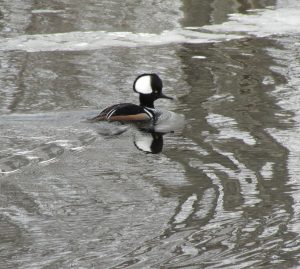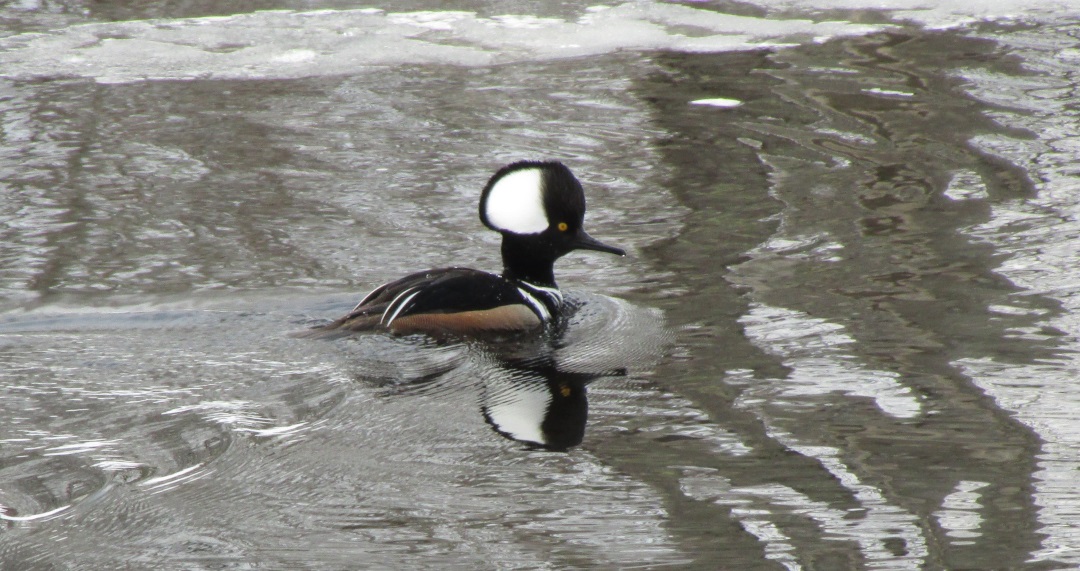Water Closet for December 29, 2017
[pullquote]”Supposedly, the Hooded merganser is the mildest tasting of this group of foul fowls, but I think I’ll have my fish straight off of the hook, thank you.”[/pullquote] A handsome small duck, the hooded merganser, visits our woodland ponds and other quiet waters now and then in spring and fall. We almost yearly get to admire a few on Creighton and Prichard ponds in Middleton. We’ve seen them playing, perhaps even hybridizing with migrating buffleheads. From a distance buffleheads and hoodies are often mistaken for one another by us amateurs. The males of both species flash white crests. Jim Berry, Northshore ornithologist, tells us that according to Forbush, hoodies were fairly rare a century ago. In the 1930s the State of Massachusetts urged folks to make nest boxes for wood ducks. Many were made. Hoodies used nest boxes too. Both also use natural cavities in rotting trees. Their populations have increased. The old Closeteer has kept a close eye on beaver activity since this mammal’s return in the 1990s. They build dams. In relatively small Middleton about fifty raise the water in our brooks and river floodplains. The red maples, swamp white oaks and floodplain-skirting pines drown. As they rot cavities form which are used by cavity nesters.

Male hooded merganser. One pound of feathers, skin, muscles, bones and gumption enjoys a swim in icy water. He is displaying crest, perhaps for the photographer. – Fred Gralenski photo
Jim and the Closeteer think this increase in cavities is another reason for the comeback of woodies and hoodies. – Naturalist Fred Gralenski from way Down East, Pembroke, Maine sent us last week’s biweekly Quoddy Nature Notes about hoodies, which he has kindly let the Stream Team use.
QUODDY NATURE NOTES by Fred Gralenski
Hooded Mergansers
We sort of have four species of mergansers here in the Western Hemisphere; the Common merganser, seen most often in our lakes and rivers; the Red-Breasted merganser, seen mostly in sheltered bays off our coast; the Hooded merganser, seen in our rivers and estuaries, and the Smew, which is very seldom seen in the Quoddy region, but may be seen in the Aleutian islands as a vagrant from Eurasia. These ‘mergansers’ are pretty separate, and the Hooded merganser, like the Smew, has a unique genus that no other existing critter has. Nevertheless, they are generally all called mergansers.
Mergansers are generally fish eating birds, and have the equipment necessary for their survival. They have long, thin serrated bills to catch and hold slippery fish, and easily dive and pursue their prey for considerable distance underwater. Most other ducks, like Black ducks and Mallards, have shorter heavier bills, and seek vegetation and also filter the mud for invertebrates for their meals. Sportsmen that came to Maine in the later 1800’s generally did not appreciate either loons or mergansers, and, before the advent of game laws, shot them at will. One writer noted that he appreciated the breech-loading rifle because with the older muzzleloader the loon would spot the puff of smoke from the hunter’s muzzleloader and dive before the bullet got there. With the breechloader and smokeless powder, the writer claimed he had more success in ridding the area of those dratted fish-eating birds.
I like the current philosophy about hunting much better. These birds do eat fish, but the type of fish consumed by mergansers is usually the smaller minnows and not the trout and salmon pursued by sportsmen. This is especially true of the Red Breasted and the Hooded merganser, who typically inhabit calmer waters, not those of the desired Maine game fish.
Hooded mergansers are sort of making a comeback in numbers. They like wooded areas, and even nest typically in hollow trees. In the early 1900’s when the eastern forests and beaver swamps were at their most depleted, Hooded mergansers, along with birds like Wood ducks, suffered from habitat loss. Nature writers, like Forbush (1912), noted that there was no record of Hooded mergansers breeding in Massachusetts, and Knight listed it as a rare breeder in Maine, but since then, with a little help, many species have made good recoveries. Our Hooded mergansers usually hang around here in the Quoddy region on some open water like on the Pennamaquan unless all of the fresh water freezes. Courtship begins in mid-winter, with displays by both partners, and in the spring the pair will select a nesting site near a small pond or slow stream in a wooded area. The female will lay upwards of a dozen eggs in her own or the nests of her neighbors. These unsuspecting moms can be Wood ducks, Buffleheads, or other mergansers. Daddies are usually pretty busy also, as hybrids with Buffleheads and other small ducks have been noted, although fertile hybrids have not been reported.
Maine has a hunting season for ducks that includes Hooded mergansers, and in the coastal zone, with proper license and rules, continues until January 4, 2018. Fish-eating ducks like mergansers are notoriously unpalatable, and I have never tasted one. Supposedly, the Hooded merganser is the mildest tasting of this group of foul fowls, but I think I’ll have my fish straight off of the hook, thank you.
Footnote: Ornithologist Berry and naturalist Gralenski both refer to Edward Howe Forbush. The Massachusetts Department of Agriculture published Forbush’s monumental work entitled Birds of Massachusetts and other New England States in 1925. The three volumes with 1500 pages of descriptions, anecdotes from hundreds of the author’s correspondents, and colored plates by Fuentes have been invaluable references for almost a century. The Water Closet’s treasured tomes were a gift from outdoorsman and Stream Teamer extraordinaire Francis Masse. They were given to him by his father, game warden Chester Masse. Forbush frosts the rich cake of facts about each bird with soaring descriptions of behavior in Victorian prose. His observations of hoodie courtship include these lines. “. . . The males, in all the splendor anew in their elegant spring plumage, seek and pay court to their prospective mates. Gallantly they dash back and forth, rippling the dark waters, expanding and contracting their fan-shaped crests, now proudly rising erect on the water, bill pointed downward and head drawn, now speeding in rapid rushes to and fro. . . .” This in only the preview of observations made while “lying prone amid grass and underbrush.”
__________________________________________________________
WATER RESOURCE AND CONSERVATION INFORMATION
FOR MIDDLETON, BOXFORD AND TOPSFIELD
| Precipitation Data* for Month of: | Sept | Oct | Nov | Dec | |
| 30 Year Normal (1981 – 2010) Inches | 3.77 | 4.44 | 4.55 | 4.12 | |
| 2017 Central Watershed Actual | 2.44 | 4.03 | 1.54 | 1.9 | |
Ipswich R. Flow Rate (S. Middleton USGS Gage) in Cubic Feet/ Second (CFS):
For Dec 21, 2017 Normal . . . 52 CFS Current Rate . . .17 CFS
——————————————————————
*Danvers Water Filtration Plant, Lake Street, Middleton is the source for actual precipitation data thru Nov.
** Middleton Stream Team is the source of actual precipitation data for Dec.
Normals data is from the National Climatic Data Center.
THE WATER CLOSET is provided by the Middleton Stream Team: www.middletonstreamteam.org or <MSTMiddletonMA@gmail.com>


go bola hello my website is go bola
tip4d hello my website is tip4d
razor88 hello my website is razor88
hobbits hello my website is hobbits
slot234 hello my website is slot234
ladybee hello my website is ladybee
rokokbe hello my website is rokokbe
bd sgp hello my website is bd sgp
jsEncrypt hello my website is jsEncrypt